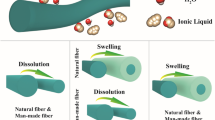Abstract
The fibrillation tendencies of various cellulosic fibers in aqueous solution containing alkali metal hydroxide and ethanol were evaluated with two specific parameters: the critical point of fibrillation (CPFconc.), that is a concentration of swelling agent where the fibrillation begins, and the ratio of initial increase in fibril number to increase in concentration of swelling agent (I i ). The CPFconc. and the I i are defined as fibrillation stability and fibrillation sensitivity to swelling agent, respectively. Lyocell fiber (CLY1) has the smallest CPFconc. and the largest I i , representing the lowest fibrillation stability and the highest fibrillation sensitivity, leading to the highest fibrillation tendency in CLY1 among the fibers tested. Although crosslinking improved fibrillation stability in lyocell as compared to modal, the fibrillation stability remained higher owing to the high water capacity and the high affinity for alkali. In alkali solution at the same concentration CLY1 fibrillation increased in the order of LiOH > NaOH > KOH. However, the plot of fibril number against solvent retention value of CLY1 in different alkaline solutions gives a slope of 110 count · g/cm3 regardless of alkali type, the critical degree of swelling for CLY1 with no fibrillation was 0.62 cm3/g in alkali solutions and 0.45 cm3/g in ethanol/water mixture.
Similar content being viewed by others
Abbreviations
- Ww:
-
weight of fibers after centrifugation (g)
- Wd:
-
weight of fibers after drying (g)
- Dalk.:
-
density of alkaline solution (g/cm3)
- ARV:
-
solvent retention value in alkaline solution (cm3/g)
- WRV:
-
solvent retention value in water (cm3/g)
- ERV:
-
solvent retention value in ethanol/water mixture (cm3/g)
- Ii:
-
initial increase in fibril number (count · l/mol)
- Vp:
-
pore volume (cm3/g)
- CPCconc.:
-
critical point of fibrillation (mol/l)
References
F. Brauneis M. Eibl (1998) ArticleTitleFinishing of knit goods produced from Lenzing Lyocell Melliand Textilberichte 79 IssueID3 155–156
K. Bredereck M. Gruber A. Otterbach F. Schulz (1996) ArticleTitleDie Hydrogelstruktur von Cellulosefasern und ihre Bedeutung fuer Fasereigenschaften und Textilveredlung Textilveredlung 31 IssueID9/10 194–200
K. Bredereck H.-W. Stefani J. Beringer F. Schulz (2003) ArticleTitleAlkali- und Fluessigammoniak-Behandlung von Lyocellfasern Melliand Textilberichte 12 58–64
D.W. Chae K.R. Choi B.C. Kim (2003) ArticleTitleEffect of cellulose pulp type on the mercerizing behavior and physical properties of lyocell fibers Textile Res. J. 73 IssueID6 541–545
H.-P. Fink P. Weigel H.J. Purz J. Ganster (2001) ArticleTitleStructure formation of regenerated cellulose materials from NMMO-solutions Prog. Polym. Sci. 26 1473–1524 Occurrence Handle10.1016/S0079-6700(01)00025-9
M. Gruber (1998) Untersuchungen zur supramolekularen Struktur und Farbstoffadsorption von Cellulosefasern Institut fuer Textil- und FaserchemieUniversitaet Stuttgart StuttgartGermany
R.N. Ibbett Y.-L. Hsieh (2001) ArticleTitleEffect of fiber swelling on the structure of lyocell fabrics Textile Res. J. 71 IssueID2 164–172
J. Kielland (1937) ArticleTitleIndividual activity coefficient of cations in aqueous solutions J. Am. Chem. Soc. 59 1675–1678 Occurrence Handle10.1021/ja01288a032
A. Kongdee T. Bechtold E. Burtscher E. Scheinecker (2004) ArticleTitleThe influence of wet/dry treatment on pore structure – the correlation of pore parameters, water retention and moisture regain values Carbohydr. Polym. 57 IssueID1 39–44 Occurrence Handle10.1016/j.carbpol.2004.03.025
J. Lenz J. Schurz E. Wrentschur (1993) ArticleTitleProperties and structure of solvent-spun and viscose-type fibers in the swollen state Colloid Polym. Sci. 271 IssueID5 460–468 Occurrence Handle10.1007/BF00657390
J. Lenz J. Schurz E. Wrentschur (1992) ArticleTitleComparative characterization of solvent spun cellulose and high wet modulus viscose fibres by their long periods Acta Polym. 43 307 Occurrence Handle10.1002/actp.1992.010430603
A. Nechwatal M. Nicolai K.-P. Mieck (1996) ArticleTitleCrosslinking reactions of spun-wet NMMO fibers and theor influence on fibrillability Textile Chem. Colorist 28 IssueID5 24–27
A. Nechwatal M. Nicolai K.-P. Mieck (1996) ArticleTitleTextile crosslinking reactions to reduce the fibrillation tendency of lyocell fibers Textile Res. J. 66 IssueID9 575–580
M. Nicolai A. Nechwatal K.-P. Mieck (1998) ArticleTitleModified fibrillation behavior of solvent-spuncellulose fibers by the reaction with reactive dyes Angew. Makromol. Chem. 256 21–27 Occurrence Handle10.1002/(SICI)1522-9505(19980401)256:1<21::AID-APMC21>3.3.CO;2-W
Okubayashi S., Griesser U. and Bechtold T., 2005. A kinetic study of moisture sorption and desorption on lyocell fibers. Carbohydr. Polym. in press.
Okubayashi S. and Bechtold T., in press. A pilling mechanism of man-made cellulosic fabrics – effects of fibrillation. Textile Res. J.
C. Rohrer P. Retzl H. Firgo (2001) ArticleTitleLyocell LF – profile of a fibrillation-free fibre from Lenzing Lenzinger Berichte 80 75–81
Taylor J.M. 1991.Fibre treatment. European Patent Application, 0,538,977 A1, 18 pp.
T. Toth J. Borsa J. Reicher P. Sally I. Sajo I. Tanczos et al. (2003) ArticleTitleMercerization of cotton with tetramethylammonium hydroxide Textile Res. J. 73 IssueID3 273–278
W. Zhang S. Okubayashi T. Bechtold (2003) ArticleTitleModification of fibrillation by textile chemical processing Lenzinger Berichte 82 58–63
Author information
Authors and Affiliations
Corresponding author
Rights and permissions
About this article
Cite this article
Zhang, W., Okubayashi, S. & Bechtold, T. Fibrillation Tendency of Cellulosic Fibers. Part 1: Effects of Swelling. Cellulose 12, 267–273 (2005). https://doi.org/10.1007/s10570-004-2786-z
Received:
Accepted:
Issue Date:
DOI: https://doi.org/10.1007/s10570-004-2786-z




